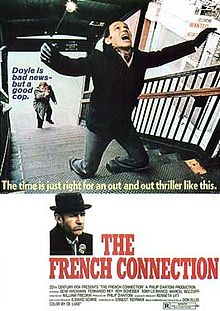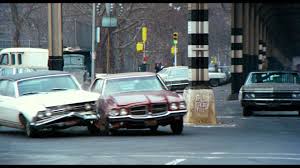1971: The French Connection

You put a shiv in my partner. You know what that means? Goddammit! All winter long I got to listen to him gripe about his bowling scores. Now I’m gonna bust your ass for those three bags and I’m gonna nail you for picking your feet in Poughkeepsie. – Popeye Doyle (Gene Hackman), showing compassion and professional competency, The French Connection
In the early 1970s, the Oscars celebrated a lot of cops and robbers, even if it wasn’t always so easy to distinguish the good guys from the bad. From 1971-1974, the Best Picture trophy went to some sort of crime tale variation, beginning with the hard edged police procedural The French Connection. Even though it’s somewhat dated today, The French Connection was revolutionary for its time with the frank depiction of ruthless and aggressive cops who break as many laws as the criminals they chase. The movie employs an almost documentary-style filmmaking technique with grainy, hand-held footage to create the sense of “you-are-there” realism that is the hallmark of procedural cop shows like Law and Order today.

Cloudy Russo (Roy Scheider) and Popeye Doyle (Gene Hackman) on stake out, just the happy cops you could meet.
Popeye Doyle (Gene Hackman) and his partner Buddy “Cloudy” Russo (Roy Scheider), two New York detectives working the drug detail, spot a pair of suspicious character at a bar that Doyle believes are drug dealers, due to their association with a suspected criminal bankroller. They begin obsessively tracking the couple – who by day run a diner. Meanwhile, Alain Charnier (Fernando Ray), a wealthy Frenchman has persuaded a French movie star to use the latter’s fame to help Charnier smuggle heroin into New York. Charnier does in fact plan to sell the heroin to the diner owner, proving Doyle’s suspicions correct. The cops, aided by their much hated federal friends, begin tracking the suspects. When the trail seems to go empty, Doyle is pulled off the case, but Charnier sends an assassin after him, leading to the film’s famous car versus train chase scene and a final confrontation between cops and crooks.

Fernando Ray as the suave drug smuggler Charnier, once again outsmarting Doyle
The poster for The French Connection tells you a lot about the movie. The gritty shot, shockingly violent for a movie poster, shows Doyle shooting a fleeing criminal in the back, the man’s face captured in dying agony. Without much context, it’s hard to know who the good guy in the scenario is (the poster even tells us that Doyle is “bad news”). The chase scene itself starts with the hitman missing Doyle by pure luck and killing an innocent bystander. Several other people die throughout the chase along with untold property damage (Doyle essentially steals a car to give chase). It should be noted the chase is the most famous part of the movie and an absolute triumph of tension and excitement that was unmatched for its time.

A still from the famous car chase scene in the French Connection
The French Connection was made at a time when America’s trust in authority was rapidly deteriorating. Popeye represents the sort of brutal, authoritarian nature of peace-keeper that is represented in that systemic distrust. He is racist, violent and alcoholic, breaking rules and endangers others with impunity. Solving crime is not about upholding law and order but merely one side of a game that Popeye will do anything to win. Popeye is one of cinema’s first Maniac Cops, the reckless rule breakers who always have a beef with their by-the-books captains and the soft system that lets criminal punks get away with so much. The formula was lessened over the years with the more cartoonish Dirty Harry (who actually also debuted in 1971) and Lethal Weapon series, among others. By the end, Doyle mistakenly kills a federal agent and shows no regret or emotion. Unlike traditional crime movies, the system is broken. The cops fight incessantly amongst themselves and with other organizations in a battle of egos. Doyle is outsmarted at nearly every turn by the criminals. In the film’s conclusion, the criminals most responsible for the crime end up receiving the least amount of punishment.
Hackman won an Oscar for playing Doyle but I don’t think he’s that good in it. Even though he’s ostensibly the lead, he disappears for a large period of time and he isn’t really the driving action of the film, which is far more plot centered than character centered. Doyle is pretty two dimensional in a lot of ways – he’s a bad boy with a badge—and I didn’t think he was all that memorable, although again, this is watching the film 45 years after it was made, when the character type he originated has really been run into the ground.
The French Connection has a lot of interesting things to say about the criminal justice system. It uses the shabby-chic stylings that made Midnight Cowboy so impactful and gritty. In today’s world, where so many of its troupes and innovations have been copied ad nauseam, a lot of its message and innovations have been lost to modern viewers.
Other Oscars: Best Director (William Friedkin); Best Actor (Gene Hackman); Best Adapted Screenplay; Best Editing
Box Office: $51.7 Million (2nd for the year)
Other Memorable Movies of 1971: A Clockwork Orange*; Fiddler on the Roof$*; Diamonds Are Forever (James Bond #7); Dirty Harry; Billy Jack; Carnal Knowledge; The Last Picture Show*; Bedknobs and Broomsticks; Klute; Shaft; THX1138 (George Lucas’s first film); Harold and Maude; Straw Dogs; Nicholas and Alexandra*; Sweet Sweetback’s Baadasssssss Song
*Best Picture Nominee
$Top Box Office: $75.6 Million
Leave a comment